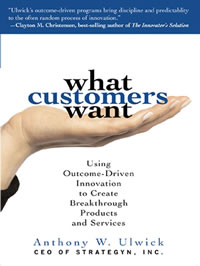
What Customers Want discusses a concrete system to create opportunities in your organization that will affect your bottom-line results. While the usual advice for creating opportunity revolves around “listening to the voice of the customer” or general brainstorming initiatives, neither of these will result in something that’s clear, measurable, and actionable.
1. Identify the specific outcomes that a customer is looking for in achieving their job (using your product or service). An outcome isn’t a specification (tangible product details), nor a need (“cheaper” or “more reliable”), nor even a benefit (“easier to use”) – since in most cases these aren’t measurable nor focused on what really matters. Instead outcomes contain the either words “minimize” or “increase”, as in:
- Increase the likelihood that the blade will begin cutting precisely on the line
- Minimize the amount of training required to use
- Minimize the time between turning it on and being able to use
For most jobs, there are between 50 and 150 desired outcomes. Your first job is to unearth them (by conversations, surveys, and focus groups). These outcomes may be blindingly obvious or hard to tease out. But capturing these outcomes is vital to ensuring your innovation process proceeds with few surprises.
2. Survey your (prospective) customers regarding the outcomes identified, asking them to rate the importance of each of these outcomes (on a scale of 1 to 5, where 5 is critically important and 1 is not important) and also their satisfaction with the product (or services) are using address these outcomes (also on a scale of 1 to 5, where 5 is completely satisfied, and 1 is not satisfied at all). During the survey, don’t forget to also obtain their physical location, job title, and contact information.
3. Calculate your opportunity scores (as well as the scores for your competition’s offering) using the formula: Importance + max(Importance – Satisfaction, 0). Something that’s important but is well-satisfied isn’t an opportunity. A top score would be 9 (critically important but not satisfied). A bottom score would be 1 (not important and completely satisfied).
4. Rank your opportunity scores to identify underserved and overserved markets, and a comparison matrix of your offering versus your competition. This will inform you what your product is missing/surpasses (relative to the competition)(overserved) and also what clearly not being addressed well (underserved).
5. Segment your surveyed responses based on commonalities of job needs (not demographics). Common needs will allow better targeting of your offering and marketing message.
6. Innovate solutions to address the needs. Instead of holding a general “How can we make our product better?” brainstorming meeting, focus the brainstorming goal to the top opportunities (step #4). Add the additional constraint “…without increasing the price” to focus on tangible solutions, rather than blue-sky thinking. Test the ideas based on how well they will change the overall opportunity score, not simply based on how easy it is to do or corporate momentum. The results may challenge normal orthodoxies and therefore create internal friction.
By using a straightforward metric to guide your internal innovation process, you’ll avoid team misunderstandings/miscommunication and increase the likelihood that you’ll have a breakthrough result.